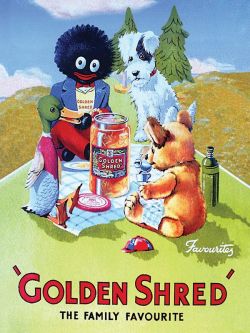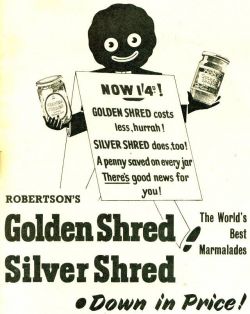Robertson's
Robertson's is a UK brand of marmalades and fruit preserves that was founded by James Robertson in 1864. The firm was run as a partnership until 1903, when it was incorporated as a limited company - James Robertson & Sons, Preserve Manufacturers, Limited. It produces the "Golden Shred" marmalade among other products.[1]
Contents
History
In 1859 he started in business in his own right as an independent grocer at 86 Causeyside Street, Paisley. In 1864 Robertson bought a barrel of Seville oranges, which are known for their bitter taste. They did not sell well. Not wanting to see her husband waste money, Mrs Robertson made a sweet tasting marmalade, which they later perfected. They rented factory space at Thrushgrove and the resultant clear and tangy marmalade was branded as "Golden Shred"; it became a commercial success. In 1880 Robertson bought land at Stevenson Street in Paisley and built a three storey, custom-made marmalade factory. The couple had developed a method to remove the bitterness of the orange, while retaining what Robertson called "the highly tonic value of the fruit". It is asserted that this same process is used in the present day to give Robertson's preserves a distinct flavour.[2]
Golly branding
Just before World War I, John Robertson (son of James Robertson) was on a tour of the United States. Whilst on a visit to the backwoods he noticed many young children playing with little black rag dolls with white eyes, made from their mothers' discarded black skirts and white blouses.[3] Intrigued by the popularity of the "Golly" (the name being the children's interpretation of doll), he thought it would make an ideal mascot and trade mark for the Robertson's range of products. Accepted by the company, Golly was first shown on Robertson literature in 1910, on items such as labels and price lists.
Discontinuation of Golly
The caricature has been described as racist, along with pickaninnies, minstrels, mammy figures, and other caricatures of black Africans.[4] The golliwog has been described by the Jim Crow Museum of Racist Memorabilia as "the least known of the major anti-Black caricatures in the United States".[5]
The Scottish jams and preserves company incorporated a golliwog in 1910 and only removed it in 2002 after complaints from campaigners. The charity Show Racism the Red Card has long-campaigned against the sale and display of golliwog dolls. A spokesman said: ‘Golliwog dolls perpetuate racism as they hark back to a time when the mockery and stereotyping of black people was considered a social norm. ‘In a multicultural and ethnically diverse Britain, such items no longer have a place.’[6]
Robertson's officially 'retired' Golly in 2002. The company had found that Golly was, on the whole, no longer popular with children, although the scheme was still successful and popular with adult collectors. Robertson's always insisted that they did not retire the Golly because of the pressure of political correctness in the 1990s, but simply for commercial reasons.[7] The brand director at Robertson's commented: "We are retiring Golly because we found families with kids no longer necessarily knew about him. We are not bowing to political correctness, but like with any great brand we have to move with the times."
External Link
Watch Golden Shred ads at Youtube
See Also
References
- ↑ Robertson's. Retrieved January 11, 2021.
- ↑ "The Old Jam Factory". WillIam McDonald. Retrieved January 11, 2021.
- ↑ Dotz, Warren; Morton, Jim (1996). What a Character! 20th Century American Advertising Icons. Chronicle Books. p. 85. ISBN 0-8118-0936-6.
- ↑ Lam, Charlotte. 'Golliwog' collector slams decision to pull doll. the Morning Bulletin. 2 December 2016. Retrieved January 11, 2021.
- ↑ Pilgrim, David (2000). The Golliwog Caricature. Ferris State University. Retrieved January 11, 2021.
- ↑ Smith, Adam.‘Offensive’ golliwog pictured on wall of fish and chip shop. Metro. 10 January 2019. Retrieved January 11, 2021.
- ↑ "Robertsons Jam to disappear". The Daily Telegraph. 7 December 2008. Retrieved January 11, 2021.



